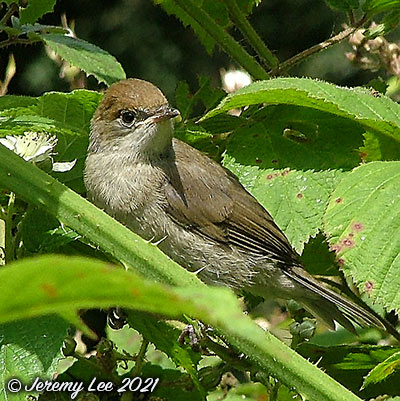
 |
|
Scientific Classifications explained » Amphibians » Ants » Aphids » Bees » Beetles » Birds » Bugs » Butterflies » Caterpillars » Damselflies » Dragonflies » Earwigs » Flies » Frog/Leafhoppers » Fungi » Galls » Grasshoppers » Harvestmen » Hoverflies » Lacewings » Ladybirds » Leaf Mines » Lichens » Mammals » Millipedes » Mosses » Moths » Sawflies » Slugs » Snails » Spiders » Trees & Shrubs » Wasps » Wild Flowers » Woodlice » Postboxes |
UK Nature > Birds > Sylvia atricapilla

Scientific Name: Sylvia atricapilla Common Name: Blackcap Sylvia atricapilla, more commonly known as the Blackcap, is a distinctive greyish warbler, the male having a black cap, and the female a chestnut one; juvenile males also have the chestnut cap. They have thin, dark-coloured beaks and brownish-grey wings. They are a similar size to robins, measuring around 13cm in length and weighing in at around 21g. Not to be confused with marsh or willow tits - the blackcap lacks the black bib both these species have. Its delightful fluting song has earned it the name 'northern nightingale'. Although primarily a summer visitor, birds from Germany and north-east Europe are increasingly spending the winter in the UK. Blackcap are best looked for in woodland, parks and gardens with plenty of trees and shrubs. In winter will readily come into gardens. Blackcaps eat a diet mostly made up of insects, including flies and caterpillars. Unlike the majority of warblers, they also enjoy eating berries, and are particularly fond of mistletoe berries. They are actually extremely efficient at spreading mistletoe seeds, eating the flesh of the berry and wiping the seed on a branch, allowing it to potentially germinate there. |
|

https://www.uknature.co.uk is a website dedicated to showing the immense diversity of UK nature and wildlife. Our vast range of habitats, from lowland arable to snow covered mountains, from storm-ravaged coastlines to peaceful inland freshwater lakes and rivers, from dry, sandy heaths to deciduous and coniferous forests, all these habitats contribute to the abundance of UK nature. We have wild birds in huge numbers either residing or visiting our shores (597 recorded species as at July 2013) and we must also not forget the humble back garden with its grass lawns, flower beds filled with nectar rich flowers, shrubs and trees, all designed to attract huge numbers of insects such as bees, moths, butterflies and hoverflies; and finally the small ponds which provide safe havens for frogs, toads, newts and even slow worms and grass snakes. www.uknature.co.uk is the showcase for my personal passion, photographing uknature in all its glory. I sincerely hope you all enjoy the fruits of my labours. This site and all images contained therein is © Jeremy Lee 2004 - 2025. All Rights Reserved. Site design by Jeremy Lee. Site development & IT Support by Stuart Lee. |